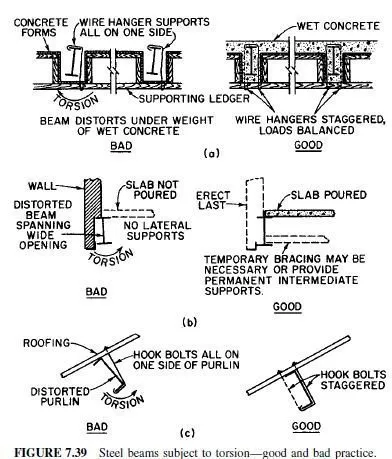This is a special type of load application, since in normal practice eccentric loads on beams are counterbalanced to the point where slight eccentricities may be neglected.
For example, spandrel beams supporting a heavy masonry wall may not be concentric with the load, thus inducing torsional stresses, but these will largely be canceled out by the equally eccentric loads of the floor, partitions, attached beams, and similar restraints. For this reason, one seldom finds any ill effects from torsional stresses.
It is during the construction phase that torsion may be in evidence, usually the result of faulty construction procedure. In Fig. 7.39 are illustrated some of the bad practices that have caused trouble in the field: when forms for concrete slabs are hung on one edge of a beam (usually the light secondary beam) the weight of the wet concrete may be sufficient to twist the beam. Figure 7.39 shows the correct method, which reduces torsion. Likewise for spandrels, the floor ties, if any, forms or the slab itself should be placed prior to the construction of the eccentric wall (Fig. 7.39b). Connectors for heavy roofing sheets when located on one side of the purlin may distort the section; the condition should be corrected by staggering, as indicated in Fig. 7.39c.
Equations for computing torsion stresses are given in Art. 5.4.2. Also, see Bibliography, Art. 7.55.



